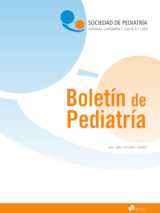¿Qué pasa durante y después del síndrome inflamatorio multisistémico pediátrico vinculado a SARS-CoV-2?
P. Miguens Iglesias , P. Rodríguez Lorenzo , L. González Calvete , J. Mayordomo Colunga , L. Calle Miguel , B. Gómez González , M. Arroyo Hernández , J. González García
Bol. Pediatr. 2023; 63 (264): 99 - 103
Objetivo. Analizar las características clínicas y analíticas de los pacientes diagnosticados de síndrome inflamatorio multisistémico pediátrico vinculado a SARS-CoV-2 (SIM-PedS) en la Comunidad Autónoma del Principado de Asturias, durante su ingreso y en los seis meses posteriores. Material y métodos. Estudio descriptivo, observacional, prospectivo (diciembre 2020 - junio 2022). Se incluyeron los pacientes menores de 18 años diagnosticados de SIM-PedS en la Comunidad Autónoma del Principado de Asturias. Se recogieron datos demográficos, clínicos y analíticos durante el ingreso y en los seis meses posteriores. Resultados. Durante el periodo de estudio, se incluyeron 16 pacientes (11 varones, edad mediana 10,6 años). Todos los pacientes tuvieron fiebre, 12 clínica gastrointestinal y 12 exantema. Todos los pacientes presentaron elevación de reactantes de fase aguda, 13 elevación de la porción N-terminal del pro-péptido natriurético tipo B, 10 linfopenia y 6 trombopenia. En la evaluación cardiológica durante el ingreso se encontraron alteraciones en seis pacientes. Todos los pacientes recibieron inmunoglobulinas, 14 corticoides y 6 inotrópicos. Nueve pacientes precisaron ingreso en la Unidad de Cuidados Intensivos Pediátricos (UCIP), con una estancia mediana de cuatro días. Un paciente falleció. No se han observado alteraciones reseñables ni en la clínica ni en la analítica ni en la evaluación cardiaca durante los seis meses posteriores al alta. Conclusiones. Los casos recogidos han mostrado las características clínicas y analíticas descritas en la literatura sobre el SIM-PedS, requiriendo más de la mitad ingreso en UCIP y recibiendo en todos los casos tratamiento con inmunoglobulinas. Presentaron frecuentemente afectación cardiológica, falleciendo un paciente. A los seis meses del episodio, ningún paciente ha mostrado afectación clínica, analítica ni de la función cardiaca.
What happens during and after multisystem inflammatory syndrome in children associated with SARS-CoV-2?
Aim. To analyze the clinical and analytical characteristics of patients diagnosed with Multisystem Inflammatory Syndrome in Children associated with SARS-CoV-2 (MIS-C) in the autonomous community of the Principality of Asturias, during their admission and in the subsequent six months. Material and methods. Descriptive, observational, prospective study (December 2020 - June 2022). Patients under 18 years of age diagnosed with MIS-C in the autonomous community of the Principality of Asturias were included. Demographic, clinical and analytical data were collected during admission and in the following six months. Results. During the study period, 16 patients were included (11 males, median age 10.6 years). All patients had fever, 12 had gastrointestinal symptoms and 12 had rash. All patients presented elevation of acute phase reactants, 13 elevation of the N-terminal portion of B-type natriuretic pro-peptide, 10 lymphopenia and 6 thrombopenia. In the cardiological evaluation during admission, alterations were found in six patients. All patients received immunoglobulins, 14 corticosteroids and 6 inotropes. Nine patients required admission to the Pediatric Intensive Care Unit (PICU), with a median stay of four days. One patient died. No notable alterations have been observed either in clinical symptoms, laboratory tests or cardiac evaluation during the six months after discharge. Conclusions. The cases collected have shown the clinical and analytical characteristics described in the literature on MIS-C, with more than half requiring admission to the PICU and receiving treatment with immunoglobulins in all cases. They frequently presented cardiological involvement, with one patient dying. Six months after the episode, no patient has shown clinical, analytical or cardiac function impairment.
Artículo completo (PDF) (77 kb.)
- Urgencias/UCIP
